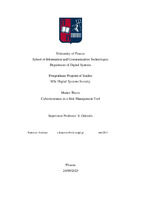Cyberinsurance as a risk management tool

Master Thesis
Συγγραφέας
Kanavas, Andreas
Ημερομηνία
2023-09-24Επιβλέπων
Gritzalis, StefanosΓκρίτζαλης, Στέφανος
Προβολή/
Λέξεις κλειδιά
Cyberinsurance ; Cyber insurance ; Risk management ; Risk treatmentΠερίληψη
In summary, this thesis comprehensively examines the field of cyber insurance, its applications, advantages, and challenges, offering insights and guidelines for leveraging cyber insurance services in the modern cybersecurity landscape. This Thesis is divided into six main chapters:
Chapter 1 introduces the topic of cyber insurance and its significance in addressing cyber threats and risks within businesses and organizations. It outlines the objectives and structure of the paper.
Chapter 2 provides an in-depth exploration of cyber insurance, starting with its definition and a thorough analysis of cyber threats and risks in modern business and organizational environments. It covers key aspects such as cyber security, various cyber threats, and introduces the ISO 27005 framework for information security risk management. The chapter also delves into the concept of cyber insurance, its coverage, policies, and different insurance programs. Categories of cyber risks are discussed along with case studies illustrating fines and penalties imposed on countries. The chapter concludes by emphasizing the importance of cybersecurity for businesses.
Chapter 3 explores the advantages and limitations of cyber insurance as a risk management tool. It highlights its role in providing financial protection, risk transfer, enhanced incident response, and risk assessment and improvement. The chapter discusses cyber insurance services and coverage, including risk assessment, and provides practical application examples and case studies. It also introduces some well-known cyber insurance companies.
Chapter 4 analyzes the types of information required for risk assessment and insurance coverage. It emphasizes the importance of communication and collaboration between insured parties and insurance companies. The process for applying cyber insurance is detailed, including steps, identification of vulnerabilities, and contract implementation. The chapter also examines the benefits of insurance companies in enhancing cybersecurity for businesses and discusses technological challenges in secure information sharing.
Chapter 5 presents comprehensive guidelines for information technology professionals on selecting, evaluating, and accepting cyber insurance. It underscores the importance of education and awareness among IT professionals.
Chapter 6 outlines an incident response management framework and highlights the collaboration between public and private organizations in addressing cybersecurity incidents. It discusses strategies for effective collaboration and information sharing between these entities and provides real-life case studies illustrating collaboration concerning cyber insurance and cybersecurity


